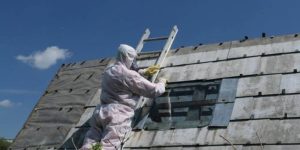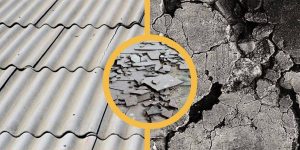Fibre Cement Asbestos: What is it?
Introduction

In construction and home renovation, two materials often come up in conversation: fiber cement and asbestos. While they have been associated in the past, understanding their differences is crucial, especially when considering health and safety. This post will delve deep into both materials and highlight how to differentiate between them.
What is Fiber Cement Sheeting?
Fiber cement sheeting is a versatile building material that has grown in popularity. Composed mainly of cement reinforced with cellulose fibers, it offers:
- Durability: Fibre cement sheets can withstand harsh weather conditions.
- Aesthetic appeal: They can be molded into various textures and finishes.
- Fire resistance: This material doesn’t catch fire easily.
- Affordability: Relative to other materials, it offers a cost-effective solution for cladding and roofing.
The Notorious History of Asbestos
Asbestos, a term that once symbolized strength and resistance in construction, now rings alarm bells due to its association with serious health risks. Derived from a group of naturally occurring minerals, asbestos became a preferred material in the 20th century because of its insulation properties, durability, and fire resistance.
However, by the latter part of the 20th century, the adverse health effects of asbestos inhalation became undeniably evident. This led to its decline in use, especially in construction.
How to Tell the Difference Between Asbestos and Fibre Cement Roof Sheets
Navigating the world of construction materials can be complex, especially when dealing with older buildings that may contain hazardous materials. A primary concern many homeowners and builders face is distinguishing between asbestos and fiber cement roof sheets. While they may seem similar to the untrained eye, subtle (and not-so-subtle) differences can help identify. It’s essential to recognize these differences for the safety and well-being of all involved. Here are some in-depth pointers:
Appearance and Texture
Asbestos Fibre Cement
- Wavy Pattern: One of the most distinguishing features of asbestos fiber cement is its wavy pattern, especially in roofing materials. This pattern was a result of the manufacturing processes of the past.
- Brittleness: Over time, asbestos can become brittle. If you find an older sheet that crumbles easily, it may contain asbestos. However, ensure you do not break or tamper with suspected asbestos material, which can release harmful fibers into the air.
Modern Fibre Cement Sheets
- Smooth Finish: Today’s fiber cement sheets are made using refined processes, leading to a smoother and more polished.
- Consistent Texture: The texture is more consistent, devoid of any lumps or irregular patterns, thanks to advancements in manufacturing.
Age of the Building

- Historical Use: Asbestos was a popular construction material, lauded for its insulation properties and durability. If the property in question was built before the 1980s, there’s a higher likelihood of asbestos-containing materials being present. This is especially true for homes built between the 1940s and 1970s, the peak period for asbestos use.
- Regulations and Bans: Due to health concerns, many countries began banning or restricting the use of asbestos in the late 20th century. Therefore, newer properties (post-1980s or post-ban period in specific regions) are less likely to contain asbestos.
Sound and Resonance
Asbestos sheets tend to produce a more hollow sound when tapped gently compared to modern fiber cement sheets. However, this method is partially foolproof and should be used with other identification methods.
Weight and Thickness
Asbestos sheets are generally lighter and thinner than their modern fiber cement counterparts. If you find old sheets that seem unusually light for their size, they might contain asbestos.
Professional Testing
While visual inspections and age considerations provide guidance, the most definitive way to ascertain the material’s nature is through laboratory testing. If you suspect the presence of asbestos, never attempt to remove it yourself. Engage a professional who can safely take a sample and get it tested in a certified lab.
Cutting and Moulding
How do you cut fiber cement sheets? It’s relatively straightforward with the right tools. The sheets can be easily cut and molded to fit various design needs.
Adherence to Standards
The Significance of Fibre Cement Cladding Australian Standards in the construction industry, maintaining rigorous standards is paramount for the stability and longevity of structures, but for the health and safety of those who build and inhabit them. When it comes to materials, the choice and quality can directly impact the overall safety and performance of a building. This is where industry standards, such as the fiber cement cladding Australian standards, come into play.
- Setting a Benchmark for Quality
- Safety First
- Environmentally Conscious
- Encouraging Transparency
- Ensuring Durability and Longevity
The Importance of Hiring a Professional Demolition Team
Venturing into demolition, especially in spaces with potential asbestos, is not a DIY task. Here’s why calling in a professional demolition contractor is essential:
Expertise and Training
Professional teams undergo rigorous training to handle hazardous materials. They can identify the difference between fiber cement and asbestos cement, ensuring proper handling.
Safety Protocols
A demolition job isn’t just about tearing down; it’s about doing so safely. Professionals adhere to strict safety guidelines, using specialized demolition tools and equipment to minimize risks to workers and the environment.
Efficiency and Speed
Their expertise and advanced tools allow professional demolition teams to complete tasks swiftly and efficiently, saving homeowners time and potential additional costs.
Correct Disposal
Dealing with materials, especially those containing asbestos, requires proper disposal methods to prevent environmental harm and health risks. Professionals ensure waste is disposed of in accordance with regulatory standards.
While the allure of a DIY approach might seem cost-effective initially, the potential risks associated with incorrect demolition, especially in spaces with materials like asbestos, are profound. It’s not just about the physical act of destruction; it’s about knowledge, experience, and ensuring safety at every step. This is why investing in a professional demolition team isn’t just a choice; it’s a necessity.
Conclusion
Understanding the materials you’re working with is paramount when embarking on a construction or renovation project. If there’s ever doubt whether a structure contains asbestos or fiber cement, consult a professional before proceeding.
Furthermore, if you’re in need of a trusted and reliable team to help you navigate the complexities of demolition, particularly in environments with potential asbestos hazards, look no further than Rapid Demolition. With years of expertise under our belt, our team is not only equipped with the latest demolition tools and techniques. Still, it is committed to ensuring every project’s utmost safety and efficiency. We pride ourselves on our client-focused approach, ensuring that every demolition is done with precision, care, and a deep respect for environmental and health standards.
Remember, while fiber cement sheets and asbestos might have a shared history, they are distinct in composition, usage, and associated risks. Always prioritize safety and stay informed. And when in doubt, let the experts at Rapid Demolition guide you. Safety first! Whether cutting a fiber cement sheet or assessing an old property, knowledge and professional assistance are your best tools.
